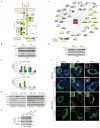Multilayered proteomics reveals molecular switches dictating ligand-dependent EGFR trafficking
- PMID: 27136326
- PMCID: PMC7618131
- DOI: 10.1038/nsmb.3218
Multilayered proteomics reveals molecular switches dictating ligand-dependent EGFR trafficking
Abstract
A fascinating conundrum in cell signaling is how stimulation of the same receptor tyrosine kinase with distinct ligands generates specific outcomes. To decipher the functional selectivity of EGF and TGF-α, which induce epidermal growth factor receptor (EGFR) degradation and recycling, respectively, we devised an integrated multilayered proteomics approach (IMPA). We analyzed dynamic changes in the receptor interactome, ubiquitinome, phosphoproteome, and late proteome in response to both ligands in human cells by quantitative MS and identified 67 proteins regulated at multiple levels. We identified RAB7 phosphorylation and RCP recruitment to EGFR as switches for EGF and TGF-α outputs, controlling receptor trafficking, signaling duration, proliferation, and migration. By manipulating RCP levels or phosphorylation of RAB7 in EGFR-positive cancer cells, we were able to switch a TGF-α-mediated response to an EGF-like response or vice versa as EGFR trafficking was rerouted. We propose IMPA as an approach to uncover fine-tuned regulatory mechanisms in cell signaling.
Figures







References
-
- Vieira AV, Lamaze C, Schmid SL. Control of EGF receptor signaling by clathrin-mediated endocytosis. Science. 1996;274:2086–9. - PubMed
MeSH terms
Substances
Grants and funding
LinkOut - more resources
Full Text Sources
Other Literature Sources
Research Materials
Miscellaneous

